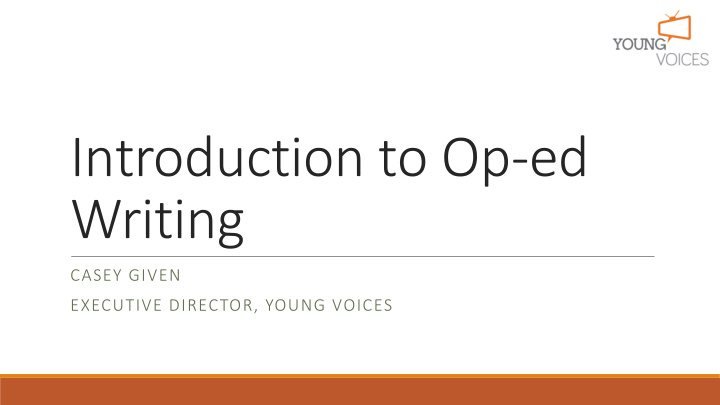



Introduction to Op-ed Writing CASEY GIVEN EXECUTIVE DIRECTOR, YOUNG VOICES
Let me introduce myself Casey Given ◦ B.A. Rhetoric, University of California, Berkeley, 2012 ◦ Policy Analyst, Americans for Prosperity Foundation, 2012-2013 ◦ Editor, Young Voices, Students For Liberty 2014-15 ◦ Director of Communications, Students For Liberty, 2015-16 ◦ Executive Director, Young Voices, 2016
Let me introduce Young Voices Founded 2013 as project of Students For Liberty ◦ Built steady list of 75 young writers (“Advocates”) ◦ Has accumulated 1,000+ media hits (i.e. print, radio, and TV) ◦ Greatest hits include The Guardian, Rolling Stone, TIME, and Chicago Tribune Transitioned to independent nonprofit in 2016 ◦ Certified nonprofit corporation in District of Columbia as of May ◦ Currently awaiting 501c3 tax-exemption from the Internal Revenue Service
What is an op-ed? “Opinion-editorial” or “opposite the editorial page” ◦ Short opinion article commenting on current events ◦ Written by outside contributors, not publication staff (i.e. columns, editorials) ◦ Typically 600-800 words, depending on the publication
Three questions to ask before writing… Who’s your audience? ◦ Who are you trying to persuade? The general public? A particular subsection? What publications address that audience? ◦ There are pros and cons of addressing a general or specific audience Are you saying something fresh and interesting? ◦ Editors are unlikely to accept your pitch unless your argument is unique
General tips and tricks Shoot for 600-800 words ◦ Readers have short attention spans, and editors even shorter Make your piece timely, but not too timely ◦ The news cycle moves fast, and editors move slow Keep sentences as concise and precise as possible ◦ Don’t believe me, take it from George Orwell…
“Politics and the English Language” ◦ Never use a metaphor, simile, or other figure of speech which you are used to seeing in print ◦ Never use a long word where a short one will do ◦ If it is possible to cut a word out, always cut it out ◦ Never use the passive where you can use the active ◦ Never use a foreign phrase, a scientific word, or a jargon word if you can think of an everyday English equivalent ◦ Break any of these rules sooner than say anything outright barbarous
Casey’s pet peeves Semicolons are the devil, and Kurt Vonnegut agrees. ◦ “Here is a lesson in creative writing. First rule: Do not use semicolons. They are transvestite hermaphrodites representing absolutely nothing. All they do is show you've been to college.” Which is which? “Which” vs. “That” ◦ Restrictive clause uses “that”: “Gems that sparkle often elicit forgiveness.” ◦ Nonrestrictive clause uses “which”: “Diamonds, which are sparkly, often elicit forgiveness.” Em dashes are commas’ (often) unnecessary cousin ◦ Commas correctly separate clauses: “Diamonds, a sparkly gem, often elicit forgiveness.” ◦ Em dashes are best for an afterthought: “One sparkly gem often elicits forgiveness — namely, diamonds.” Avoid the “L” word (or “C” word) ◦ Nobody cares about your political ideology! Persuade your audience with reason. Don’t pigeonhole yourself.
Anatomy of an op-ed
The introduction The hook— signal to your readers what the topic of the The thesis— article is state your argument up front
The hook Use the news This Wednesday evening Frances Newton, 40, will be put to death for the murders of her husband and two children 18 years ago… Use an anniversary Fifty years after the Supreme Court banned school segregation, the battle over the racial composition of America' s schools continues in courtrooms across the country. Cite a major new study According to a new nation-wide poll, 60% of women have cheated on their husbands at least once. Get Personal College admissions officers around the country will be reading my applications this month, essays in which I describe personal aspirations, academic goals -- even, in one case, a budding passion for the sitar. What they won't know is that I actually graduated from college more than a year ago, and that the names attached to these essays are those of my duplicitous clients.
Citing evidence Cite studies, Provide links statistics to your experts, and sources, even anecdotes that if the support your publication evidence won’t use them
Good sources Bureau of Economic Analysis (BEA) — bea.gov ◦ GDP, personal income, consumer spending Census Bureau — census.gov ◦ Population, state and local revenue, expenditures, and debt Bureau of Labor Statistics —bls.gov ◦ Unemployment rate, state and local employment, Consumer Price Index (CPI) National Center for Education Statistics — nces.ed.gov ◦ NAEP scores, graduation rates, school revenue and expenditures
Good sources Tax Foundation ◦ State and local tax rates State Budget Solutions ◦ State unfunded liabilities Gallup ◦ Historical polling data The Usual Suspects ◦ Center-right: Cato Institute, Heritage Foundation, American Enterprise Institute, State Policy Network, etc. ◦ Center-left: Center for Budget & Policy Priorities, Brookings Institution, Pew Charitable Trusts, RAND Corporation
The conclusion Summarize your argument in one paragraph
Let’s make a match What publication best fits the tone of your piece? ◦ Is it hip and quirky? Wonky and serious? What is their submission process? ◦ Who do you email? And how long should you wait to hear back? What is the format of the website? ◦ Do published authors have a bio and mug shot?
Contact Young Voices Check out our website — youngvoicesadvocates.com Contact me — cgiven@youngvoicesadvocates.com Apply to become an Advocate — youngvoicesadvocates.com/apply
Recommend
More recommend